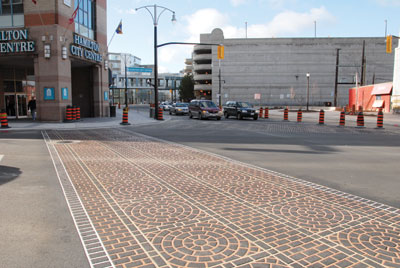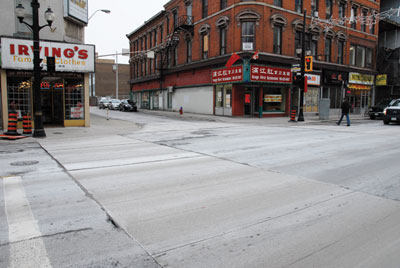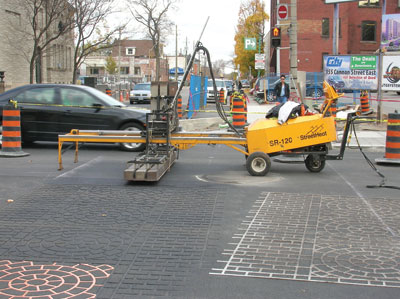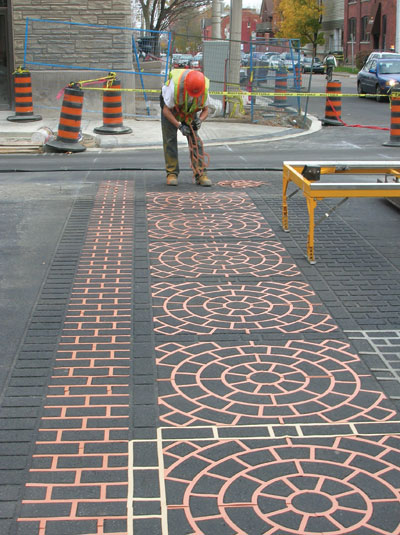
Features
Columns
Education
Laying it Down
The City of Hamilton in southern Ontario is upgrading some of its downtown streets and crosswalks
February 10, 2011 By Bill Tice
Things are starting to look a little different in the downtown core of
Hamilton, Ontario, as a revitalization and beautification plan takes
shape.
Things are starting to look a little different in the downtown core of Hamilton, Ontario, as a revitalization and beautification plan takes shape. Known as “Steeltown” for its heritage in Canada’s steel industry, Hamilton, which is about an hour southwest of Toronto, converted traffic on one of the city’s main thoroughfares from one-way to two-way traffic, replaced the existing water main, resurfaced the road, completed island modifications, reconstructed sidewalks, added streetscaping and installed decorative lighting.
 |
|
| The City of Hamilton had a budget of almost $4 million for street upgrades, including new crosswalks.
|
Most of the work was done on York Boulevard between two other major streets –Queen Street South and James Street North. The roadwork was coordinated with the renovation of Hamilton’s Farmers’ Market and the Central Library facility. The area also houses Jackson Square shopping mall, Hamilton City Centre shopping mall and Copps Coliseum, which is an events centre that can accommodate up 19,000 people for concerts and sports events and offers almost 120,000 square feet of exhibition space for trade shows and other large scale meetings and conferences.
 |
|
| The city's old crosswalks were high maintenance and contained rough areas and cracks. |
As part of the roadwork for the project, the City of Hamilton’s Public Works department specified the inclusion of highly visible and extremely durable crosswalks using a product from Surrey, B.C.-based Integrated Paving Concepts Inc., which distributes decorative asphalt products in more than 40 countries. The product, which is called DuraTherm, is a design flexible and durable thermoplastic system that is inset into asphalt pavement using Integrated Paving Concepts’ patented StreetHeat® asphalt reheating technology.
 |
|
| The area where DuraTherm will be installed is heated up.
|
The DuraTherm crosswalks replace the standard crosswalks that have been in the area for years. “It is a higher cost item when compared to traditional crosswalks, but there is a definite payback,” explains Mike Becke, the city’s project manager – Engineering Services, Design section. “We estimate that higher cost to be in the neighborhood of about 40%, but where we save money is in our ongoing maintenance,” he says as he points to the cracks and raised edges of an older concrete crosswalk that hasn’t been changed yet. “See that high spot in the old crosswalk?,” he adds. “When our snow plows hit that, the surface of the crosswalk gets damaged, the plow blade gets damaged and the plow driver gets quite a jolt. With the DuraTherm crosswalks, it is seamless, we have one continuous layer of asphalt over top of the concrete and the DuraTherm is embedded in the asphalt.
 |
|
| A crew member places the DuraTherm in place in what the City of Hamilton's Mike Becke says "is almost like a jigsaw puzzle."
|
Becke says it’s not the first time the City of Hamilton has used DuraTherm. “We initially used this product back in 2004 in the area of McMaster University,” he notes. “Although we have been happy with the product at McMaster, we learned quite a bit from our first experience and by evaluating how it has stood up. The main thing we found was that in turning lanes, especially where buses and larger vehicles frequently turn right, the asphalt wears down, and because of that, we lost quite a bit of the colour in the Dura-Therm. We can reheat that asphalt and bring the colour back up by adding more DuraTherm, but this time around we have used a newer version of the DuraTherm product and gone deeper with it, so it should be maintenance free for a longer period of time.”
Becke adds that going the extra depth doesn’t impact the cost of the project by much. “Over the entire project, it cost us about an extra $3,000 to go deeper with the DuraTherm, which is really insignificant when you are looking at a project of this magnitude.”
The Process
For the downtown project, Becke says they started out by laying 50mm of Super Pave asphalt over top of a concrete base. Next, they use an infrared heater that is on a track system to heat up the areas where the Dura-Therm will be installed before laying in design templates that have been pre-approved by the City. These templates come in sheets and once laid down, the installation crew uses a plate tamper to embed the templates pattern into the hot asphalt. The templates are then removed and can be re-used. The Dura-Therm, which is impregnated with glass beads for reflectivity, is then fused to the asphalt in the areas where the templates were located. “It’s almost like a jigsaw puzzle,” says Becke. “The great thing about this product is it is quick to install and once it is installed, we can have traffic rolling over it as soon as it cools down, whereas with concrete, you have to let it cure for seven days so it is quite disruptive to your traffic patterns. With this product, we can just shutdown one lane at a time and keep the traffic flowing through the area.”
Budgets
Not including the work being done to upgrade the Farmers’ Market and the library, the budget for the York Boulevard project was $3.8 million. The first phase, which was primarily the renovations to the two city-owned buildings, was started in May 2009 with a $16 million budget. The road building part of the project was started a year later in May 2010 and was completed in late December 2010 so that the traffic patterns were in place and all roadwork was finished in time for the February 2011 opening of the market.
 |
|
| Mike Becke
|
In addition to Becke, the project design team included senior project manager Chris McCafferty, design technician Claudio Leon, landscape architect Lawrence Stasiuk, project manager (electrical) Mike Field, project manager (traffic) Rodney Aitchison, and design technician (traffic) Sandra Lucas. The City’s construction project manager was John Cowperthwaite. The landscape architect consultant on the project was Glenn O’Connor of G. O’Connor Consultants Inc. in Burlington, Ont. and the construction contractor was Dufferin Construction Company, which has its head office in Oakville, Ont. The subcontractor who installed the street print was Multiseal.
Print this page